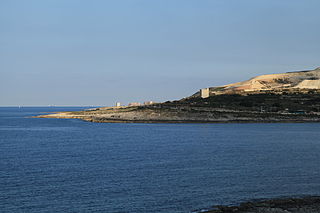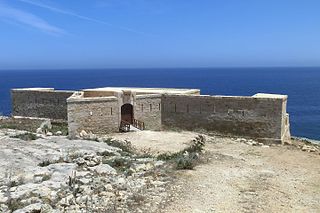
Comino is a small island of the Maltese archipelago between the islands of Malta and Gozo in the Mediterranean Sea, measuring 3.5 square kilometres (1.4 sq mi) in area. Named after the cumin seed, the island has a permanent population of only two residents and is part of the municipality of Għajnsielem, in southeastern Gozo, from where one priest and one policeman commute. The island is a bird sanctuary and nature reserve.

Saint Thomas Tower, also known as Fort Saint Thomas, is a large bastioned watchtower in Marsaskala, Malta. It was built in 1614, the third of six Wignacourt towers. An artillery battery was added to the tower in the early 18th century. Saint Thomas Tower holds the record as the largest watchtower in Malta.

Fort San Lucian, also known as Saint Lucian Tower or Fort Rohan, is a large bastioned watchtower and polygonal fort in Marsaxlokk, Malta. The original tower was built by the Order of Saint John between 1610 and 1611, being the second of six Wignacourt towers.

Wignacourt Tower, also known as Saint Paul's Bay Tower, is a bastioned watchtower in St. Paul's Bay, Malta. It was the first of six Wignacourt towers to be built, and the first stone was laid on 10 February 1610. It replaced the role of Ta' Tabibu farmhouse which was previously known as Dejma Tower. An artillery battery was added a century later in 1715. Today the tower is a museum of fortifications around the Maltese Islands.

Saint Agatha's Tower, also known as the Red Tower, Mellieħa Tower or Fort Saint Agatha, is a large bastioned watchtower in Mellieħa, Malta. It was built between 1647 and 1649, as the sixth of the Lascaris towers. The tower's design is completely different from the rest of the Lascaris towers, but it is similar to the earlier Wignacourt towers. St. Agatha's Tower was the last large-bastioned tower to be built in Malta.
This page list topics related to Malta.

The De Redin Towers are a series of small coastal watchtowers built in Malta by the Order of Saint John between 1658 and 1659. Thirteen towers were built around the coast of mainland Malta to act as watchtowers. Eight of the towers still survive.
The Lascaris Towers are a series of mostly small coastal watchtowers built in Malta by the Order of Saint John between 1637 and 1652. The first seven towers were built around the coast of mainland Malta in 1637 and 1638. Between 1647 and 1652, a large tower was also built on mainland Malta, and two smaller ones were built on Gozo.
The Wignacourt towers are a series of large coastal watchtowers built in Malta by the Order of Saint John between 1610 and 1620. A total of six towers of this type were constructed, four of which survive.

Santa Maria delle Grazie Tower, also known as Delle Grazie Tower, Madonna delle Gratie Tower or Blata Bajda Tower, was a watchtower in what is now Xgħajra, Malta. It was constructed in 1620, and was the last of six Wignacourt towers to be built. The tower was demolished in the late 19th century by the British military.
Marsalforn Tower refers to two towers that stood near Marsalforn, in the limits of Xagħra, Gozo, Malta. The first one was built in 1616, as the fourth of six Wignacourt towers, and collapsed around 1715. The second was a Tour-reduit, which was built in 1720 and demolished in 1915.
Vittorio Cassar, born Gio Vittorio Cassar, was a Maltese architect and military engineer. The son of the renowned architect Girolamo Cassar, he was admitted as a knight within the Order of St. John in 1587. He became the Order's resident engineer in the early 17th century, and he directed the upgrading of the Cittadella of Gozo between 1600 and 1603.

Garzes Tower, also known as Saint Martin's Tower, was a watchtower built in Mġarr, Gozo by the Order of Saint John in 1605. It was named after Martin Garzez, the Grand Master who financed its construction, even though it was eventually built after his death during the Magistry of Alof de Wignacourt. The tower was demolished in the 19th century; some remains were reused for the building of a bridge, and the site was developed with a hotel.

Saint Julian's Tower, originally known as Torre di San Giuliano and also known as Sliema Tower, is a small watchtower in Sliema, Malta. It was completed in 1658 as the fifth of the 13 De Redin towers. An artillery battery was built around the tower in 1715. Today, the tower and the remains of the battery are a restaurant.

The fortifications of Malta consist of a number of walled cities, citadels, forts, towers, batteries, redoubts, entrenchments and pillboxes. The fortifications were built over hundreds of years, from around 1450 BC to the mid-20th century, and they are a result of the Maltese islands' strategic position and natural harbours, which have made them very desirable for various powers.

Saint Anthony's Battery is an artillery battery in Qala, Gozo, Malta. It was built by the Order of Saint John in 1731 and 1732 as one of a series of coastal fortifications around the coasts of the Maltese Islands. It is one of only two surviving batteries on Gozo, the other one being Qolla l-Bajda Battery in Żebbuġ.

Saint Mary's Battery, also known as Comino Battery, is an artillery battery on the island of Comino in Malta. It was built by the Order of Saint John between 1715 and 1716 as one of a series of fortifications around the coasts of the Maltese Islands.

San Rocco Battery was an artillery battery in Kalkara, Malta, built by Maltese insurgents during the French blockade of 1798–1800. It was the last in a chain of batteries, redoubts and entrenchments encircling the French positions in Marsamxett and the Grand Harbour. It was built to control the entrance to the harbour as well as the French occupied Fort Ricasoli. The battery was continually being fired upon by the French at Fort Ricasoli, which was located about 700 m (2,300 ft) away.

Vendôme Tower is a tour-reduit in Marsaxlokk, Malta. It was built by the Order of Saint John in 1715 as one of a series of fortifications around the coasts of the Maltese Islands. It is the only surviving tour-reduit in Malta. Today, Vendôme Tower houses the headquarters of Marsaxlokk F.C.
Saint Mary's Redoubt, also known as Migart Redoubt, was a redoubt on the island of Comino in Malta. It was built, mainly with limestone, by the Order of Saint John in 1716 or 1761 as one of a series of coastal fortifications around the Maltese Islands.

















